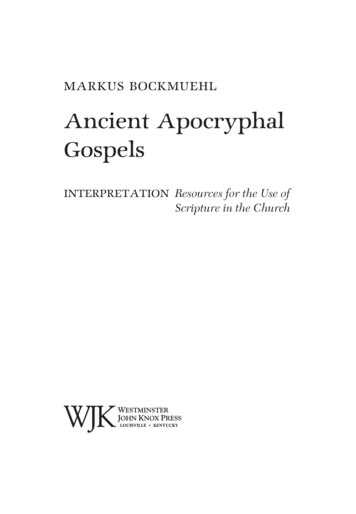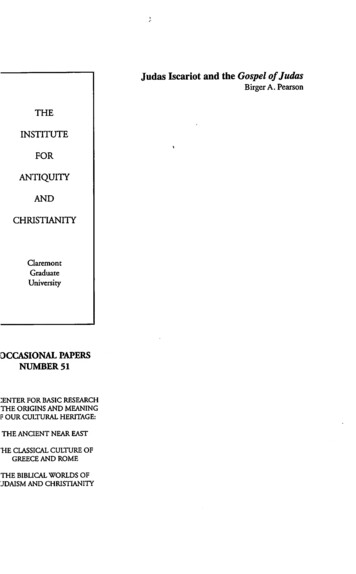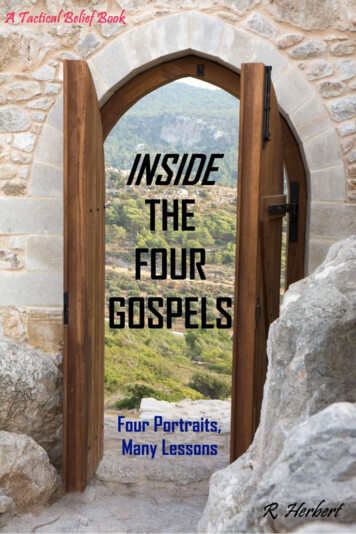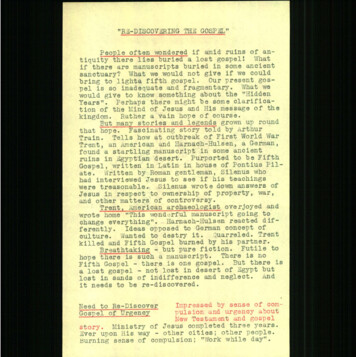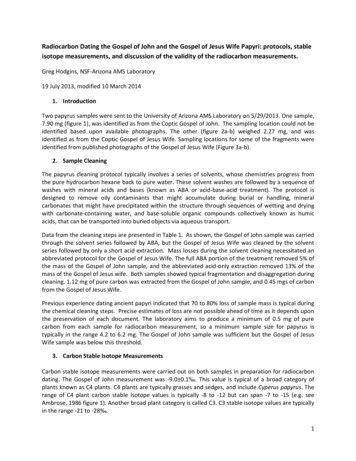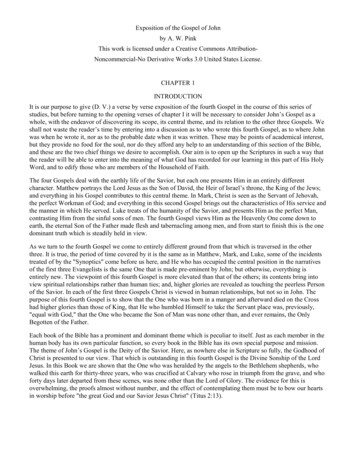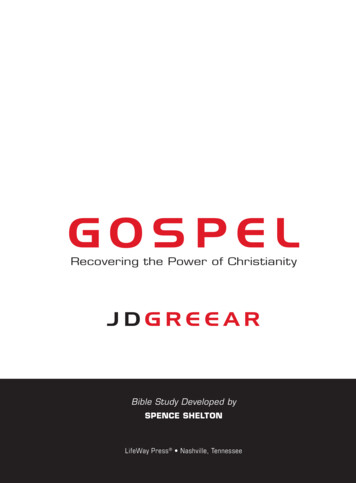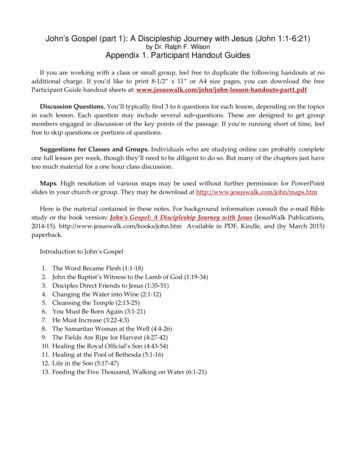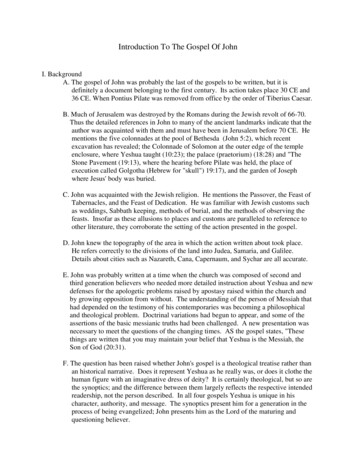
Transcription
Introduction To The Gospel Of JohnI. BackgroundA. The gospel of John was probably the last of the gospels to be written, but it isdefinitely a document belonging to the first century. Its action takes place 30 CE and36 CE. When Pontius Pilate was removed from office by the order of Tiberius Caesar.B. Much of Jerusalem was destroyed by the Romans during the Jewish revolt of 66-70.Thus the detailed references in John to many of the ancient landmarks indicate that theauthor was acquainted with them and must have been in Jerusalem before 70 CE. Hementions the five colonnades at the pool of Bethesda (John 5:2), which recentexcavation has revealed; the Colonnade of Solomon at the outer edge of the templeenclosure, where Yeshua taught (10:23); the palace (praetorium) (18:28) and "TheStone Pavement (19:13), where the hearing before Pilate was held, the place ofexecution called Golgotha (Hebrew for "skull") 19:17), and the garden of Josephwhere Jesus' body was buried.C. John was acquainted with the Jewish religion. He mentions the Passover, the Feast ofTabernacles, and the Feast of Dedication. He was familiar with Jewish customs suchas weddings, Sabbath keeping, methods of burial, and the methods of observing thefeasts. Insofar as these allusions to places and customs are paralleled to reference toother literature, they corroborate the setting of the action presented in the gospel.D. John knew the topography of the area in which the action written about took place.He refers correctly to the divisions of the land into Judea, Samaria, and Galilee.Details about cities such as Nazareth, Cana, Capernaum, and Sychar are all accurate.E. John was probably written at a time when the church was composed of second andthird generation believers who needed more detailed instruction about Yeshua and newdefenses for the apologetic problems raised by apostasy raised within the church andby growing opposition from without. The understanding of the person of Messiah thathad depended on the testimony of his contemporaries was becoming a philosophicaland theological problem. Doctrinal variations had begun to appear, and some of theassertions of the basic messianic truths had been challenged. A new presentation wasnecessary to meet the questions of the changing times. AS the gospel states, "Thesethings are written that you may maintain your belief that Yeshua is the Messiah, theSon of God (20:31).F. The question has been raised whether John's gospel is a theological treatise rather thanan historical narrative. Does it represent Yeshua as he really was, or does it clothe thehuman figure with an imaginative dress of deity? It is certainly theological, but so arethe synoptics; and the difference between them largely reflects the respective intendedreadership, not the person described. In all four gospels Yeshua is unique in hischaracter, authority, and message. The synoptics present him for a generation in theprocess of being evangelized; John presents him as the Lord of the maturing andquestioning believer.
II. Occasion.A. Because of the rather defensive doctrinal position it takes, the gospel of John mayhave been written to combat the rising tide of Cerinthianism which threatened thetheological foundation of the church. According to Irenaeus, Cerinthus was a teacherwho contended the Yeshua was merely a human personality who was possessed by theMessiah Spirit at his immersion and relinquished this spirit on the cross.B. Contrary to this teaching, the John asserts that the Word became flesh (John 1:14), andthat the descent of the Holy Spirit on Yeshua at his immersion was the proof of hismission, not the origin of it (1: 32-34). The cross did not terminate his ministry; itsimply marked the end of one stage of it. The Son returned to the Father in person; hedid not cease to be the Son by death. The stress on sonship throughout the gospelconveys the idea that it was a live issue in the church, and that impression isstrengthened by the warning "Such a man is the antimessiah – he denies the Fatherand the Son No on who denies the Son has the Father; whoever acknowledges theSon has the Father also. (1 John 2:22-23).III. PurposeA. John wrote his gospel to meet the spiritual need of a church that had little backgroundin the Tenach and that may have been endangered by the plausible contention ofCerinthus or men like him. John's intention is stated with perfect clarity: "Many othersigns therefore Yeshua also performed in the presence of the disciples, which are notwritten in this book; but these have been written that you may believe that Yeshua isthe Messiah, the Son of God; and that believing you may have life in His name.B. Yeshua was the Logos who had come into the world from another sphere (1:14). Heperformed miracles, or "signs" that illustrated his powers, especially applied to humanneed. He died an unusual death, but he rose from the dead to send his disciples out ona universal mission. The last sentences of the gospel imply the promise of his return.A entirely new revelation of the plan and power of God is latent in this gospel(1:18).IV. Theme.A. The word "believe" (pisteuo) appears ninety eight times in the gospel, more often thanany other key word, and is obviously the major theme. All the signs, teachings, andevents in the gospel are used to stimulate faith in Messiah, and are so ordered that theymark the growth in this faith on the part of his disciples. Growth was not alwaysuniform, as Simon Peter's experience shows, and generally was countered by a growthof unbelief , as seen in the conduct of Yeshua's enemies. The conflict between beliefand unbelief , exemplified in the actions and words of the main characters forms theplot.
B. Following is an outline of the gospel of John based on its theme, belief.I. The prologue: the proposal for belief.1:1-18II. The presentation for belief.1:19-4:54III. The reactions of belief and unbelief.5:1-6:71IV. The crystallization of belief and unbelief.7:1-11:53V. The crises of belief and unbelief.11:54-12:50VI. The assurance for belief.13:1-17:26VII. The rejection by unbelief.18:1-19:42VIII. The vindication of belief.10:1-31IX. Epilogue: The dedication of belief.
Outline Of The Gospel Of JohnI. The Prologue (1:1-18)A. The Logos in eternity and time (1:1-5)B. The witness of John the Immerser (1:6-8)C. The coming of the Light (1:9-13)D. The incarnation and revelation (1:14-18II. Yeshua's manifestation to the nation of Israel (1:19-12:50)A. Yeshua's early ministry (1:19-4:54)B. Yeshua's controversy in Jerusalem (Chapter 5)C. Yeshua's revelation in Galilee (6:1-7:9)D. Yeshua's return to Jerusalem and the resumption of hostility (7:19-10:39)E. The great sign at Bethany (11:1-44)F. The plot to kill Yeshua 11:45-57)G. The conclusion of Yeshua's public ministry (12:1-36)H. Jewish national unbelief (12:37-50)III. Yeshua's preparation of his disciples (chapters 13-17)A. The last supper (13:1-30)B. Yeshua's coming departure (13:31-38)C. Yeshua, the way to the Father (14:1-14)D. Yeshua's promise of the counselor (14:15-31)E. The Vine and the branches (15:1-10)F. Yeshua's friends (15:11-17)G. The world's hatred (15:11-16:4)H. The Spirit's work (16:5-15)I. The prediction of changes (16:16-33)J. Yeshua's intersession (chapter 17)IV. Yeshua's passion and resurrection (Chapters 18-20)A. The arrest of Yeshua (18:1-11)B. The religious trial and Peter's denials (18:12-26)C. The civil trial ((18:28-19:16)D. The crucifixion (19:17-30)E. The burial (19:31-42)F. The empty tomb (20:1-9)G. Yeshua's appearance to Mart (20:10-18)H. Yeshua's appearance to his disciples (20:19-23)I. Yeshua's appearance to Thomas (20:24-29)J. The purpose of the book (20:30-31)V. The epilogue (chapter 21)A. Yeshua's appearance by the lake (21:1-14)B. Yeshua's reinstating of Peter (21:15-23)C. The colophon (21:24:25)
The Gospel of JohnThe Purpose of the bookWhen reading the gospel of John, it is advisable to keep in mind John's reason for writing thebook. This is stated in Jn. 20:30-31: Many other signs therefore Yeshua also performed in thepresence of the disciples, which are not written in this book; but these have been written that youmay believe that Yeshua is the Messiah, the Son of God; and that believing you may have life inHis name.Throughout the book, Yeshua performs a number of signs (miracles). These signs were toconfirm what the Tenach said about Messiah, that he would give sight to the blind, hearing to thedeaf, etcetera to testify the truth of his claim to be the anointed one.Also testifying to Yeshua's Messiahship were the words he spoke. Anyone reading the gospelwith an open mind will realize that "Never did a man speak the way this man speaks" (Jn. 7:46).The words and works of Yeshua, as recorded in the gospel of John, testify that he was truly theMessiah, the Son of God.AuthorshipIn the strict sense of the term, the gospel is anonymous. No name of the author is given in thetext. However, an author may indirectly reveal himself within the writing, or his work may bewell known in tradition as coming from him.Internal evidence supplies the following chain of connections regarding the author of the fourthgospel:1. In John 21:24 the word "them" refers to the whole gospel, not just the last chapter.2. The disciple in 21:24 was "the disciple whom Yeshua loved" (21:7).3. From 21:27 it is certain that the disciple whom Yeshua loved was one of the seven personsmentioned in 21:2.4. The disciple whom Yeshua loved was seated next tot the Lord at the last supper, and Petermotioned to him (13:23-24).5. He must have been one of the twelve since only they were with the Lord at the last supper.6. In the gospel John was closely related to Peter and thus appears to be one of the inner three.Since James, John's brother died in the year A.D. 44, he was not the author.7. The other disciple (John 18:15-16) seems to refer to the disciple whom Yeshua loved, since heis called this in 20:2.8. The disciple whom Yeshua loved was at the cross (19:26) and 19;35 seems to refer to him.9. The author's claim "We have seen his glory" 1:14), was the claim of someone who was aneyewitness (cf. 1 Jn. 1:1-4).Putting all of these facts together makes a good case for the author of the fourth gospel havingbeen John, one of the sons of a fisherman named Zebedee.1
External evidenceThe external evidence is the tradition of authorship which has been well known in the church.Polycarp (ca. A.D. 69-ca. A.D.155) spoke of his contact with John. Irenaeus (ca. 130- ca. 200),the bishop of Lyons heard Polycarp and testified that "John, the disciple of the Lord, who alsohad leaned against his breast had himself published a gospel during his residence in Ephesus inAsia. Polycrates, Clement of Alexandria, Tertullian, and other late fathers support this tradition.Eusebius was specific that Matthew and John wrote the two gospels which bear their specificnames.Place of originThe external tradition is strong that John came to Ephesus after Paul had founded the church andthat he labored in that city for many years. Supporting this tradition is the evidence ofRevelation 1:9-11. When John was in exile on Patmos, an island off the coast of Asia Minor, hewrote to seven Asian churches, the first of which was Ephesus. That the fourth gospel wasoriginally published at Ephesus is a good probability.DateThe date for the gospel of John was probably between A.D. 85 and 95. Some critics haveattempted to assign a date as late as A.D. 150 on the basis of the books alleged similarities toGnostic writings or because of a supposed long development of church theology. Archeologicalfinds supporting the authenticity of the text of John (e.g. John 4:11; 5:2-3), word studies,manuscript discoveries, and the dead sea scrolls have given powerful support to an early datingfor John. So it is common today to find nonconservative scholars arguing for a date as early asA.D. 45-66. But this gospel has been known as the fourth one, and the early church fathersbelieved that it was written when John was an old man. Therefore a date between 85 qnd 95 isbest.Chapter II. Yeshua the Word of God (1-5)A. In the beginning recalls the opening words of the book of Genesis. However, there isdifference between these two passages. Genesis begins with the point at which timebegan, the creation of the world. John goes beyond time into eternity. Since creation isnot mentioned until verse three, the first two verses must refer to an earlier period.Thus, in Jn. 1:1, "the beginning referrers to timeless eternity.B. The term "word" is the Greek word logos. It means "speaking, a message, or words."The term was familiar to John's readers, but he gave it its own meaning as he applied itto Yeshua.C. A good paraphrase of 1:1 is "Before the beginning began, the word already existed.D. The preposition "with" in the phrase "the word was with God" indicates both equalityand distinction of identity. The phrase can be rendered "face to face with." Theeternal coexistence and unity of the Word with God is asserted.E. "The word was with God" is not merely repetitious of verse one. It prepares the wayfor his partnership with God in the activity that begins in the next clause: "All things2
came into being through him.F. All things came into being through him relates to the universe, its elements, and itssystems of law. The word "made" (egeneto) has the meaning "became" rather than"constructed. This refers to an occurrence to an event without elapsed time, an event,not a process.G. A literal translation of verse three is "All things came into being through him. TheGreek grammar here contrasts the event of creation with the continuous existence ofthe Word. The wording of the phrase also indicates the creation of substance fromnothing.H. Yeshua came to reveal the Father (Jn. 1:14,18). This work of revelation began increation for creation reveals God (Ps. 19:1-6; Rom. 1:19-20).I. Verse three tells us that "apart from him was not anything made that was made." Thissignifies that Apart from the word, existence is impossible. From its beginning, andfrom moment tot moment, everything that exits apart from god owes its existence toGod.J. The term "life" (zoe) is used throughout the gospel. It refers either to physical life or,more often, to spiritual life. It is often coupled with the adjective "eternal" to denotethe quality of the believer's life. This life is found in Messiah, who demonstratedperfectly what eternal life is by his career. In Messiah God's purpose and power aremade available to men.K. Light is often used in the Bible as an emblem for God. Darkness is commonly used todenote death, ignorance, sin, and separation from God. Isaiah described the coming ofsalvation as the people living in darkness seeing a great light (Is. 9:2).L. Light's nature is to shine and dispel darkness. Darkness is almost personified in versefive: darkness is unable to overpower light. By this John summarized his gospelrecord: (a) light will invade the dominion of darkness. (b) Satan the ruler and hissubjects will resist the light, but they will be unable to frustrate its power. (c) TheWord will be victorious in spite of opposition.II. The witness of John the Immerser. (6-8)A. In conformity with Old Testament prophecy, God sent a forerunner to announce thecoming of the Messiah and make ready the people fort his appearance. John's humanpersonality was emphasized by the term used in the Greek text: "There came a MAN"– meaning a human and not some other kind of being. His divine commission isasserted, but he is not said to have a divine nature. The author was careful to specifythat John the Immerser was not the genuine light but that he came to attest to it.B. This does not, however, minimize the importance of John. He was a man uniquelysent from God. The Greek word translated "sent" is apestalmenos from which theword "apostle" is derived. This verb carries the sense of sending out an envoy with aspecial commission. In the case of John, he was sent from God. The preposition parameans "from beside" and invests the messenger with greater authority and significancethan had he simply been sent by God.3
III. The true light. (9)A True (alethinon) means "real" or "genuine" as opposed to "facsimile," secondary'" or"false." An alternate (and possibly better translation of this verse may be: He was thereal light that illuminates every man as he comes into the world. Messiah's functionwould be to give the light of truth to all his ministry would affectB. Messiah gives light to every man. This does not mean universal salvation or generalrevelation or even inner illumination. Instead it means that Messiah as the Light shineson each person either salvation or in illuminating him with regard to his sin andcoming judgment.C. Light stands in contrast with darkness that is everywhere present. The Greeks had twowords for darkness. Zophos was a poetic term signifying the idea of gloom, \nebulousness, or a kind of half darkness. John uses the stronger term, skotia, ninetimes in his gospel. He calls darkness the natural sphere of those who hate good(3:19-20), and contrasts it with Yeshua, the light of the world.IV. The world. (10)A. The world (kosmos) means the world of men and human society which is now indisobedience to God and under the rulership of Satan. The Logos came among peoplein the incarnation, but mankind did not recognize its maker.B. The failure to recognize him was not because God's nature was somehow "hidden" inpeople. Rather, it is because of human ignorance and blindness, caused by sin.V. His rejection. (11)A. In the phrase, "He came to His own, and those who were His own did not receiveHim," the former "own refers to his home, and the later "own" refers to his ownpeople, the nation he belonged to. He found no welcome in his home, and his peoplerejected him.B. In rejecting him, they refused to accept him as the revelation sent by the Father andrefused to receive his teaching. Isaiah long before had prophesied of this nationalunbelief: "Who has believed our message?" (Is. 53:1)C. In spite of the many who rejected the Word, there were some who received him. Thisprovides the initial definition of "believe" by equating it with "receive." When weaccept a gift, we demonstrate our confidence in its reality and trustworthiness. Wemake it a part of our own possessions. By being so received, Yeshua gives to thosewho receive him a right to membership in the family of God.D. People are not naturally children of God but can become so by receiving the gift of thenew birth.VI. The new birth. (12-13)A. The new birth does not come by natural descent (of blood), nor is it the result ofhuman decision (the will of the flesh), nor is it the result of a husband's will (the will4
of man). The birth of a child of god is not a natural birth.B. One becomes and has the right to be a child of God by believing in the name ofYeshua. This is more than an intellectual acceptance of the revealed truths concerningYeshua. To believe in that name involves absolute transfer of trust from self to theSavior.C. The new birth is a supernatural work of God in regeneration. A person welcomesYeshua and responds in faith and obedience to him, but the mysterious work of theHoly Spirit is the cause of regeneration (3:5-8).VII. The incarnation and revelation of the Word. (14-16)A. The incarnation means that Messiah became the God-man. He did not merely appearas a man; he became one. The word sarx, translated "flesh," signifies human nature.It means more than merely acquiring a physical body, although that is part of theincarnation. Messiah also assumed human nature, thus identifying completely withmankind, having a human body, soul, and spirit. Of course, Yeshua did not acquire asin nature, as that was not originally part of human nature.B. Not only did the word become flesh, he also condescended to dwell among humans.John uses the word eskenosen, which literally means to pitch a tent or tabernacle. Thefigure in John's mind was probably the tabernacle in the Tenach. The tabernacle wasthe dwelling place of God and the meeting place of God and Israel, making it the mostperfect type of Messiah, the word incarnate, in the Tenach. Just as the Shekinah gloryof God rested over the holy place in the tabernacle, so john observes "we beheld hisglory." The veiled glory of God in Yeshua was apparent to those who had eyes to see.C. "We beheld his glory" implies that the author was an eyewitness. Hi glory refers tothe unique splendor and honor seen in Yeshua's life miracles, death, and resurrection.It may also allude to John's witness of the transfiguration.D. "The only " begotten of the Father means that Yeshua is the son of God in a sensetotally from a human who believes and becomes a child of God. Yeshua's Sonship isunique for he is eternal and is of the same essence of the Father. The gloriousrevelation of God which the Logos displayed was full of grace and truth; that is, itwas a gracious and truthful revelation.E. Grace and more grace.1. Verse 16 expresses the idea of inexhaustible grace. When one supply of graceis exhausted, another is available. God's grace is infinite, inexhaustible, andfully efficacious.2. This grace is demonstrated by the works of Yeshua. His compassion, empathy,and ability to make a man whole were a true reflection of the character andabilities of the Father.VIII. Law verses grace. (17)A. The law represented God's standard of righteousness. Grace exhibits his attitude5
toward human beings who find that they cannot keep the law.B. Moses, the author of the law, was perhaps the greatest of the Old Testament prophets.The law, though a monumental work, was never intended to impart righteousness toman. Rather, it was "a tutor to lead us to Messiah" (Gal. 3:24). It revealed ourshortcomings ands lack of the qualities that justify one before God. On the other hand,Messiah, the author of grace Messiah, on the other hand, gives us grace. He perfectlyfollowed the law, lived a life in conformity with God's righteousness, and imparted thatrighteousness to we who believe.IX. Yeshua reveals God. (18)A. No one has ever seen God. The Greek word used in verse 18 is heoraken, whichdenotes the physical act but also emphasizes some mental discernment of what is seen.Yeshua, of course, was God and was seen by humans, but only after he had emptiedhimself of the glory that was rightfully his (Phil. 2:7).B. Verse 18 means no one has seen God's essential nature. God may be seen in atheophany or anthropomorphism but his inner essence or nature is disclosed only inYeshua.C. John ends the prologue by returning to the truth stated in verse 1 that the Word is God.The Son has made known the Father, for in him and by his works the nature andessence of the invisible God are displayed.X. The ministry of John the Immerser. (19-34)A. The ministry of John was so influential that the authorities in Jerusalem decided toinvestigate him. "the Jews" refers to the religious bureaucracy, particularly thosePharisees hostile to the gospel. Both priests and Levites were sent to John. Thepriests were descendents of Aaron. Levites included others from the tribe of Leviwho were not priests.B. John denied he was the Messiah. The title Messiah means "anointed." It was appliedto the deliverer God had promised to the Jewish nation.C. John denied he was Elijah. The last promise of the Tenach says:5 Behold, I am going to send you Elijah the prophet before the coming of the great andterrible day of the Lord.6 And he will restore the hearts of the fathers to their children, and the hearts of thechildren to their fathers, lest I come and smite the land with a curse (Mal. 4:5-6).D. John denied that he was the prophet. "The Prophet" was a reference to Deut. 18:15,where Moses prophesied:The Lord your God will raise up for you a prophet like me from among you, from yourcountrymen, you shall listen to him (Deut. 18:15).6
E. John's denial of being Elijah creates a problem in light of Messiah's later identificationof John with Elijah (Matt.17:10-13). Three possible solutions to this problem havebeen suggested:1. The Jews were looking for a literal incarnation of Elijah, whereas John wasmerely the spirit of Elijah and not the physical Elijah they were asking about.2. John was ignorant as to his complete significance in history and had not yetrealized he was Elijah.3. Some give as a third option that this is the law of double fulfillment, that Johnthe Immerser was the first fulfillment, and there will be a second, literalfulfillment before Messiah comes in his glorious appearing. Yeshua indicatedto his disciples that the literal fulfillment of the Elijah prophecy was still for afuture time (Matt.17:11).F. John's high respect for Messiah is emphasized in the words and expressions he used todescribe both himself and Yeshua.1. Most Old Testament prophets claimed they were speaking the word of God, butin this chapter only Yeshua is the Word. John merely identifies himself as a"voice" (1:23). As important as the ministry of john was in the fulfilling ofScripture and preparation for Yeshua's ministry, in contrast with the Word,John saw himself only as a noise in the wilderness.2. A second word that emphasized John's attitude toward Yeshua is the verb"stands" (1:26). Esteken means stands in the sense in the sense of a firm orpersistent standing. John recognizes Yeshua as the Messiah standing in theirmidst and here bears witness of him , emphasizing the dignified attitude ofMessiah.3. The Immerser declares himself unfit to untie the thongs of Yeshua's sandals. Inancient times, the untying of sandal thongs was the duty of the lowest slave inthe household. John the Immerser's reference to this practice in this contextemphasizes his humility. It is no wonder the later prominence of Yeshua atJohn's expense was welcomed by John (3:30).G. The next day, John saw Yeshua coming to him. The word blepo ("saw") has the ideaof a short, single glance. The spiritual perception of John was such that a singleglance was all that was necessary to identify the Lamb of God.H. One of the twenty two titles of Messiah in John is "Lamb of God." When most Jewsof Yeshua's day though of their coming Messiah, they though in terms of a politicalliberator, not a suffering servant. Being the son of a priest, John was well aware of theimportance of the lamb offered every morning and evening, as well as the Passoverand other sacrifices. John's reference to Yeshua as the Lamb of God was probablybased on his understanding of Isaiah 53 and the sacrificial system of Israel. Just as alamb was offered on the alter for sin, so the Lamb of God would be offered on a crossfor the sin of the world.7
I. The verb airon ("takes away") has the idea of taking something and carrying it awayto destroy it. The means by which Yeshua took away sin was to bear it in his ownbody and so remove our transgressions from us as far as the east is from the west.and He Himself bore our sins in His body on the cross, that we might die to sin andlive to righteousness; for by His wounds you were healed (1 Pet. 2:24).As far as the east is from the west, so far has He removed our transgressions from us(Ps. 103:12).J. Another interesting aspesct of this message of John concerning Yeshua is in his choiceof hamartian rather than hamartias. The word used by John for "sin" is singular,plural. While the atonement of Messiah is sufficient for all sins, he died for the sinprinciple that has separated people from God. Under the law a lamb was sacrificedfirst for a man, then his family, then the nation. Now the Lamb of God removes the sinof the world.K. The conclusion of John's message about Yeshua is that he is the Son of God. John hadearlier heard the voice of the Father identifying Yeshua as his beloved Son. In thisGospel, John is the first of several who recognize Yeshua as the Son of God. While itwas a messianic title, it meant more than that. The Hebraism "the Son of" meant ofthe same nature and character. To call someone "the Son of God" was to recognizethe nature and character of God in that person.L. Why did john say, "I did not know him?" Though john and Yeshua were related,nothing is known of any contacts between them in their years of childhood andadolescence. John did not know that Yeshua was the coming One until he wasrevealed by the Father. All John knew was that he was to prepare the way for him bybaptizing with water. God would send his anointed One to Israel in his good time.M. The immersion of Yeshua is not recorded in John's gospel, but is recorded in thesynoptic gospels. Upon his immersion, the invisible Spirit came from heaven andmanifested himself in a bodily (dovelike) form. John had been told by god that whenthis occurred, the person so marked by the Spirit's coming would be the One whowould baptize in the Holy Spirit.N. Upon seeing this, John testified:32 And John bore witness saying, "I have beheld the Spirit descending as a dove out ofheaven, and He remained upon Him.33 And I did not recognize Him, but He who sent me to baptize in water said to me, "Heupon whom you see the Spirit descending and remaining upon Him, this is the onewho baptizes in the Holy Spirit."34 And I have seen, and have borne witness that this is the Son of God (John 1:32-34).8
O. This declaration refers back to verse 18. The title "Son of God' goes beyond the ideaof obedience and Messianic king to Yeshua's essential nature. In the fourth gospel,this title is not applied to believers. They are called children of God, while onlyYeshua is called the Son. Since Yeshua shared the nature of the Father, he was able toreveal him understandably. Yeshua is the final word from God, and perfectly explainshim.XI. Yeshua's first disciples. (35-51)A. Two of John's disciples heard the witness of the Immerser and followed Yeshua. Theword "followed" probably has a double meaning here. They followed him in the senseof literal walking and also as his disciple
The gospel of John was probably the last of the gospels to be written, but it is definitely a document belonging to the first century. Its action takes place 30 CE and 36 CE. When Pontius Pilate was removed from office by the order of Tiberius Caesar. B. Much of Jerusalem was destroyed by the Romans during the Jewish revolt of 66-70.


